Leopardus
| Leopardus[1] | |
|---|---|
-8.jpg) | |
| Ocelot, Leopardus pardalis | |
| Scientific classification | |
| Kingdom: | Animalia |
| Phylum: | Chordata |
| Class: | Mammalia |
| Order: | Carnivora |
| Suborder: | Feliformia |
| Family: | Felidae |
| Subfamily: | Felinae |
| Genus: | Leopardus Gray, 1842 |
| Type species | |
| Leopardus griseus Gray, 1842 | |
| Species | |
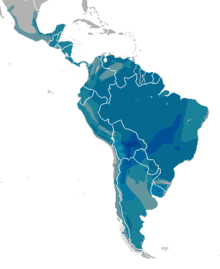 | |
| Leopardus diversity | |
Leopardus is a genus of spotted small cats mostly native to Middle and South America, with a very small range extending into the southern United States. The genus is considered the oldest branch of the part of the cat family to cross into the Americas, followed by the genera Lynx and Puma. (The jaguar is the other extant cat native to the Americas.) The largest species in Leopardus is the ocelot; most of the other species resemble domestic housecats in size, with the kodkod (L. guigna) being the smallest cat in the Americas. The margay (L. wiedii) is more highly adapted to arboreal life than any other cat in the Americas.[2]
Despite the name, leopards are members of genus Panthera, not Leopardus.
Taxonomy
There has been some revision of this branch of Felidae in recent years. Leopardus was previously regarded as a subgenus of the genus Felis. The Pantanal and Pampas cats were previously considered subspecies of the colocolo.
Genetic studies indicate the genus Leopardus forms a distinct clade within the feline subfamily, and first evolved in South America around 10 to 12 million years ago (Mya). Within the genus, two distinct evolutionary lineages appear to exist; one leading to the ocelot, margay, and Andean mountain cat, and the other leading to the remaining species.[3]
Species
The following species are recognised following the taxonomic revision of the Felidae, 2017:[4]
| Image | Scientific name | Common Name | Distribution |
|---|---|---|---|
-8.jpg) | L. pardalis (Linnaeus, 1758) | ocelot | Southwestern United States, Mexico, Central and South America |
 | L. tigrinus (Schreber, 1775) | oncilla, tigrina | Central America up to central Brazil |
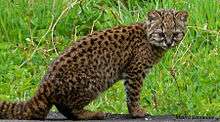 | L. guigna (Molina, 1782) | kodkod | Central and southern Chile and marginally in adjoining areas of Argentina |
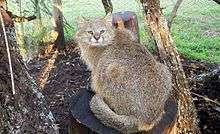 | L. colocola (Molina, 1782) | Pampas cat, colocolo | Argentina and Uruguay into the Gran Chaco and Cerrado of Bolivia, Paraguay and Brazil, and north through the Andes mountain chain through Ecuador and possibly marginally into southwestern Colombia |
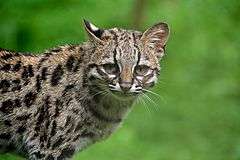 | L. wiedii (Schinz, 1821) | margay | Southern Mexico, through Central America and in northern South America east of the Andes to Uruguay and northern Argentina |
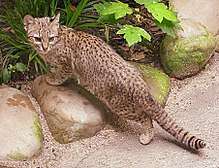 | L. geoffroyi (d'Orbigny & Gervais, 1844) | Geoffroy's cat | Bolivia to southern Chile |
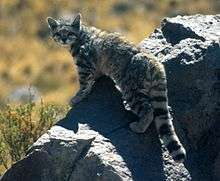 | L. jacobitus (Cornalia, 1865) | Andean mountain cat | Chile, Bolivia, Argentina and central Peru |
| L. guttulus (Hensel, 1872) | southern tigrina | Brazil, Argentina and Paraguay | |
References
| Wikimedia Commons has media related to Leopardus. |
| Wikispecies has information related to Leopardus |
- ↑ Wozencraft, W.C. (2005). "Order Carnivora". In Wilson, D.E.; Reeder, D.M. Mammal Species of the World: A Taxonomic and Geographic Reference (3rd ed.). Johns Hopkins University Press. pp. 537–540. ISBN 978-0-8018-8221-0. OCLC 62265494.
- ↑ Reid, F. A. (2009). A Field Guide to the Mammals of Central America and Southeast Mexico (2 ed.). Oxford University Press. p. 277. ISBN 978-0-19-534323-6.
- ↑ Johnson, W.E. et. al. (1998). "Tracking the evolution of the elusive Andean mountain cat (Oreailurus jacobitus) from mitochondrial DNA" (PDF). Journal of Heredity. 89 (3): 227–232. doi:10.1093/jhered/89.3.227. PMID 9656464.
- ↑ Kitchener, A.C.; Breitenmoser-Würsten, C.; Eizirik, E.; Gentry, A.; Werdelin, L.; Wilting, A. & Yamaguchi, N. (2017). "A revised taxonomy of the Felidae: The final report of the Cat Classification Task Force of the IUCN Cat Specialist Group" (PDF). Cat News. Special Issue 11.